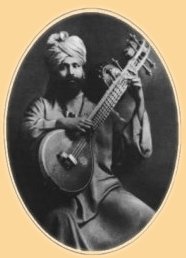ARTICLE
Hazrat Inayat Khan: From Maestro to Master
Part one of an essay on this remarkable
musical pioneer, by the UK's leading critic, broadcaster and author, Jameela
Siddiqi.
published in the
January 2004 issue of veena Indian Arts Review.

The year is 1910, and a ship sails
into New York harbour. One of the passengers, an Indian musician, catches
his first glimpse of the Statue of Liberty. On sighting that gigantic and
impressive monument, he observes that it is 'awaiting the moment to rise
from material liberty to spiritual liberty.' Little could anyone have guessed
that towards the end of his brutally short life-span of forty-five years
(1882-1927), he was destined to play a pioneering role in laying the foundations
for bridges between the spiritual and material worlds, at that time clearly
defined as 'East' and 'West.' In his biography, that journey is described
as being transported 'by destiny from the world of music and poetry to
the world of industry and commerce.'
The Sufi teacher Hazrat Inayat Khan
(of Baroda) was a significant pioneer in two ways. He was the first person
to bring Indian music to the West and he was also the first to transport
Sufism to the West. Ironically, he had to give up the former - his first
love -- in order to pursue the latter, driven by an overwhelming and compelling
urge going against all the odds, to spread the spiritual message of Sufism
in the western world. In his own words: 'I gave up my music because I had
received from it all I had to receive. To serve God one must sacrifice
the dearest thing, and I sacrificed my music, the dearest thing to me.'
He arrived in the West at a time
when Europe stood on the threshold of the First World War, the after effects
of which were to leave western society permanently and irrevocably changed.
European wars and politics were to touch his personal and professional
life in many different ways. Inayat Khan was able to observe the impact
of nationalism and jingoism at first hand and while the First World War
offered a backdrop against which he was able to perfect his groundbreaking
theories on the mysticism of sound and music in terms of discord and harmony
as represented by warlike nationalism, while his daughter, Noorunissa,
many years after his death, found herself in the midst of the Second World
War as a heroine of the French Resistance movement, and was eventually
shot by the Nazis.
In today's India, unless you specify
you mean 'Sufi' Inayat Khan, it is generally assumed that you are referring
to one of the two other eminent classical musicians of the same name. The
vast repository of textbooks on Indian classical music make absolutely
no reference to Hazrat Inayat Khan who was, undoubtedly, not only one of
the greatest musicians of his time, but had also composed poems in Farsi,
Urdu and Hindi. These recordings, made on 78 r.p.m records lay neglected
in mint condition within the EMI archives in London for some 90 years!
Some amazing detective work, carried out by the Australian scholar Michael
Kinnear in 1994, uncovered the entire collection of 31 songs recorded by
Inayat Khan during his stay in Calcutta in 1909. On hearing these recordings
and Inayat Khan's full-throated ghazals, khayals, taranas, bhajan and dhrupad,
one cannot help but realise that this is the real thing.
In India itself, Inayat Khan's name
in connection with classical music seems to have lapsed from local memory
once he left for America in 1910. While that is understandable, what is
really surprising is that Inayat Khan's most important publication on music,
Minqar-e-Musiqar (Allahabad Indian Press, 1913), one of the most
definitive works on the theory and practice of Indian classical music (including
full delineations of some 450 raags!), has never ever been translated into
English or any other language, given the vast demand overseas for authoritative
works on Indian music.
|